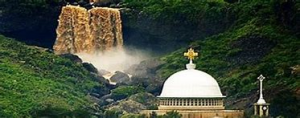 After 104 km north of Addis Ababa on the road to the historic route there is a 13th century religious center. Debre Libanos is a monastery in Ethiopia, lying northwest of the capital. Founded by the monastery’s Ichege known as the chief abbot was the second most powerful official after the Patriarch in the church.
After 104 km north of Addis Ababa on the road to the historic route there is a 13th century religious center. Debre Libanos is a monastery in Ethiopia, lying northwest of the capital. Founded by the monastery’s Ichege known as the chief abbot was the second most powerful official after the Patriarch in the church.

The monastery complex sits on a terrace between a cliff and the gorge of Jama Valley on the drainage system of Blue Nile River. St. Tekle Haymanot, the most valued saint in Ethiopian Orthodox church, which was a critical figure in establishing Ethiopian national identity. He was influential in “restoring” the Solomonic dynasty and revitalizing monasticism, which were central to both religious and cultural life.

Detail information
Founded in 1284 by Abuna Tekle Haymanot, Debre Libanos Monastery served as the centre of the Ethiopian Church for almost 500 years. Today, the site has a calm, tranquil feel, situated amongst pleasant woodland and streams, but in 1937 this was the site of one of the worst atrocities of the Italian occupation. Fascist troops attacked and destroyed the monastery, killing 297 monks, more than 100 deacons and at least 400 lay people. Although a new church was constructed on the site in the 1950s, it never regained the same status it previously held as a centre of religious learning. It does, however, remain an important pilgrimage site for Orthodox Christians, who come to pay homage to the bones of the massacred monks.

Tekle Haymanot was an influential religious and political figure who was instrumental both in spreading Christianity through the region and in reinstating the rule of the Solomonic dynasty after several centuries of Zegwe reign. He is usually depicted with six wings and one leg. Tradition has it that after spending seven years standing on one leg, praying, his other leg fell off.


